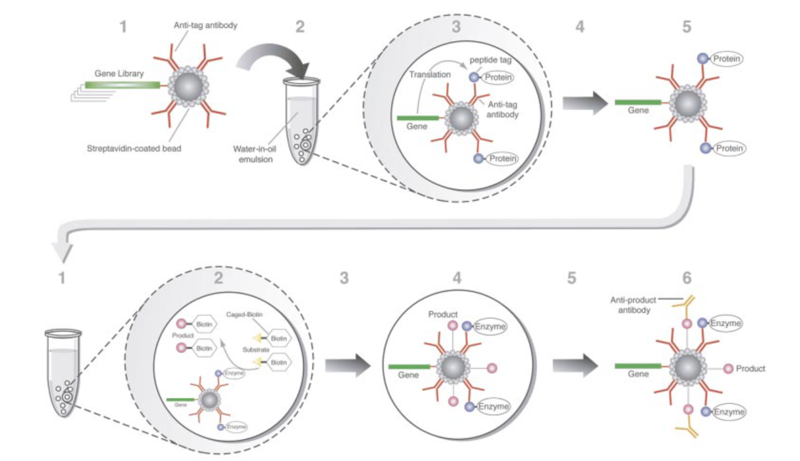CH391L/S12/In vitro Selection: Difference between revisions
Adam Meyer (talk | contribs) |
Adam Meyer (talk | contribs) |
||
| Line 13: | Line 13: | ||
=====Gene Shuffling===== | =====Gene Shuffling===== | ||
Multiple, related genes can be randomly recombined to form novel genes. Genes are randomly fragmented with DNaseI. Fragments from multiple genes are mixed together and thermocycled (with PCR reagents). Fragments from different parents anneal at regions of homology and are extended by a DNA Polymerase. Full-length, shuffled constructs are then amplified by normal PCR. | |||
=====Mutator Strains===== | =====Mutator Strains===== | ||
A plasmid can be propogated in a mutator strain of bacteria, which usually lack some DNA proofreading machinery. Alternatively, dNTP analogs can be added to the media to increase the mutation rate. | A plasmid can be propogated in a mutator strain of bacteria, which usually lack some DNA proofreading machinery. Alternatively, dNTP analogs can be added to the media to increase the mutation rate. | ||
Revision as of 12:14, 29 January 2012
Overview of in vitro selection
Library Generation
Randomized Oligodeoxynucleotides
Randomized oligodeoxynucleotides are generated using traditional solid-phase phosphoramidite chemistry. At the "N" positions, an equimolar mixture of the 4 bases are used, thus giving an equal probability of each base at that position on a given nascent oligodeoxynucleotide.
If there is a known, functional sequence that can serve as a starting point, then a pool can be mildly randomized (yielding a "doped" pool). In a doped pool, a mixture of all four bases are used, but the molarity is skewed to favor the wild-type base at each given position.
Randomized oligodeoxynucleotides be assembled into the final template, most often by PCR.
Mutagenic PCR
A wild-type starting sequence can be concomitantly mutated and amplified using mutagenic PCR. Infidelity can be achieved using an error-prone DNA polymerase, increasing the magnesium content, including manganese, using non-canonical dNTPs (e.g. 8-oxo-GTP), or altering the ratio of the dNTPs.
Gene Shuffling
Multiple, related genes can be randomly recombined to form novel genes. Genes are randomly fragmented with DNaseI. Fragments from multiple genes are mixed together and thermocycled (with PCR reagents). Fragments from different parents anneal at regions of homology and are extended by a DNA Polymerase. Full-length, shuffled constructs are then amplified by normal PCR.
Mutator Strains
A plasmid can be propogated in a mutator strain of bacteria, which usually lack some DNA proofreading machinery. Alternatively, dNTP analogs can be added to the media to increase the mutation rate.
This method of library generation has the drawback that the entire plasmid is subject to mutation (ie mutation is not confined to the gene under selection).
Neutral Drift
Increased Representation
Once diversity is created, the selection must must allow function variants to become a larger percentage of the pool. This step is often the most difficult to design.
Affinity
The easiest function to enrich for is affinity for a ligand. To select for binders (aptamers for nucleic acids; antibodies and others for proteins,) one exposes the pool of potential binders to a fixed ligand. The best binders affix to the ligand while weaker binders are washed away. Those that remain can be amplified for further round of selection.
For nucleic acids, the binder itself can be subject to amplification, as it is both the information-carrying and function-carrying molecule. In Ellington and Szostak (1990), A DNA library was created such a T7 promoter drives expression of an N100 RNA pool, flanked by constant regions. The pool is passed through a column with a bound ligand. Species that bind the ligand are retained on the column and weaker binders are washed away. Binders are eluted from the column and amplified to begin a new round.
For protein binders, the scheme must include linking of the information-carrying nucleic acid to the function-carrying protein. Some examples of this linking are phage display, cell-surface display, and ribosome display.
Selective Amplification
Bartel 1993
Protection
The first in vitro evolved protein functions involved modification of the nucleic acid species that encoded it. Perhaps the first such function was protection of the DNA template. In Tawfik and Griffiths (1998) The template encodes HaeIII methyl transferase. Upon transcription and translation in bacterial lysate, active methyltransferase methylate HaeIII recognition sequences in the gene. The methylated genes are then protected from digestion by HaeIII endonuclease. Undigested templates are then amplified before the next round. The key to this experiment is the use of in vitro compartmentalization (described below)which allow an active methyltransferase to methylate its parent template, but not other templates in the pool.
